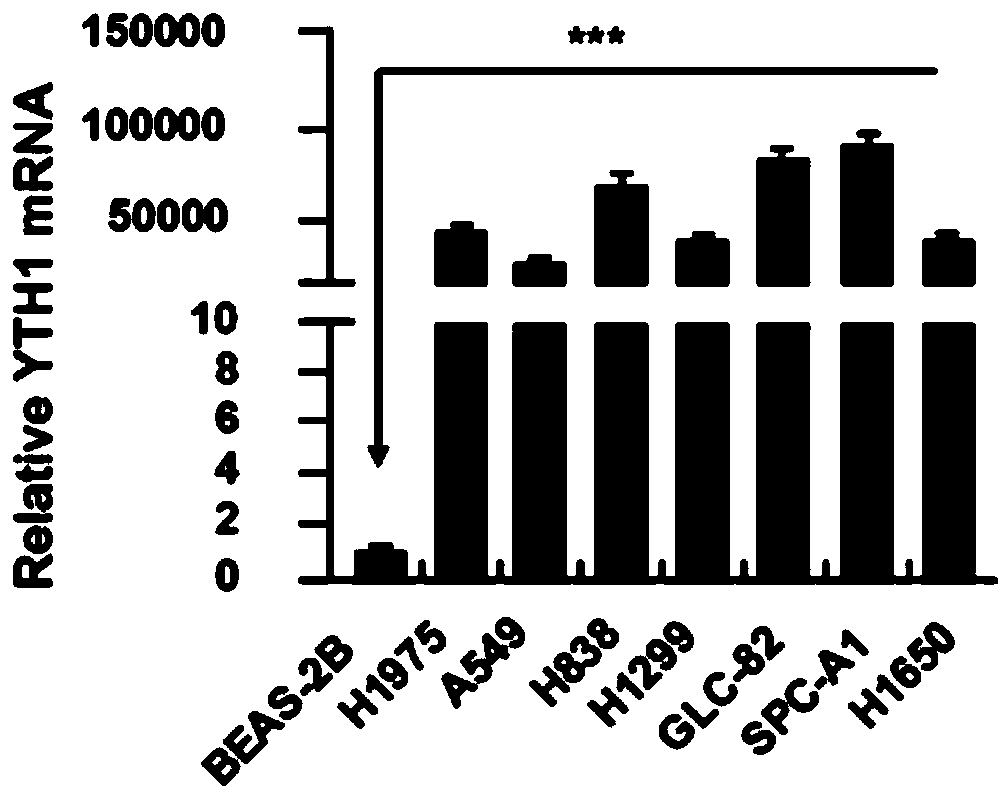Application of human YTHDF1 (Youth-Tech-Health Domain Family Member 1) gene
A gene and gene expression technology, applied in the field of new uses of genes, can solve the problems of lung cancer cell occurrence, incomplete development, survival rate of less than 15%, and unsatisfactory clinical efficacy.
- Summary
- Abstract
- Description
- Claims
- Application Information
AI Technical Summary
Problems solved by technology
Method used
Image
Examples
Embodiment 1
[0053] Example 1: RT-PCR assay detects the expression of YTHDF1 in lung cancer cell lines
[0054] 1. Extraction of total cellular RNA
[0055] (1) When normal lung epithelial cells and lung cancer cells grow to 80% coverage, remove the supernatant, wash away the serum with PBS, add 1mL TRizol, and place it horizontally for 5 minutes to ensure that TRizol is evenly distributed on the cell surface and lyse the cells. Let the cells fall off the culture dish, transfer all the liquid to the centrifuge tube, and repeatedly pipette until there is no obvious large precipitate in the lysate; stand at room temperature for 5 minutes;
[0056] (2) Centrifuge at 12,000g for 5min in a centrifuge at 4°C, and transfer the supernatant to a new 1.5mL centrifuge tube;
[0057] (3) Add 200 μL of chloroform, vortex, and centrifuge at 12,000 g for 15 min in a centrifuge at 4°C, after which the liquid is divided into three layers;
[0058] (4) Absorb the upper aqueous phase (be careful not to tou...
Embodiment 2
[0076] Example 2: Western blot detection of YTHDF1 protein expression
[0077] 1. WB (Western Blotting) detection
[0078] 1.1 Extraction of total cell protein
[0079] After the cells were treated according to the specific experiment, the supernatant medium was discarded, and washed once with PBS; the corresponding cell lysate was added according to the amount of the cell pellet, and the freeze-thaw lysed 3 times, during which the pipetting was continued; 4°C, 12000rpm centrifugation After 10 min, the supernatant was discarded and the precipitate was used for subsequent experiments.
[0080] 1.2 Protein concentration detection and denaturation treatment
[0081] The protein concentration detection kit is Biyuntian BCA protein concentration detection kit (enhanced type), item number: P0010S, the method is as follows:
[0082] Add 0, 1, 2, 4, 8, 12, 16, and 20 μL of the standard into the standard wells of the 96-well plate, and add the standard diluent to make up to 20 μL, s...
Embodiment 3
[0087] Embodiment 3: clinical experiment
[0088] 1. Immunohistochemical experiment
[0089] Lung cancer tissue chips and lung cancer pathological tissue slices were obtained in cooperation with the Department of Pathology, Xiangya Hospital, Central South University. Tumor samples from nude mice were fixed in formalin and then sliced in wax. The samples were baked at 80°C for 2 hours. Soak in xylene for dewaxing, gradient alcohol dehydration, immerse in 0.3% hydrogen peroxide (methanol and water preparation) solution for 15 minutes to remove tissue peroxidase, rinse with Tris buffer saline (TBS), and microwave at 95°C for 20 minutes for antigen retrieval. Recover at room temperature for 1 hour; then wash three times with TBS, incubate with 5% goat serum for 30 minutes to remove non-specific binding, primary antibody anti-YTHDF1 (Proteintech, 11515-1-AP, 1:200), anti-cleaved-caspase 3 (CC3 :CST, 9661S, 1:1000), anti-Ki67 (MAXIM Biotechnologies, MAB-0005, ready to use), anti-...
PUM
 Login to View More
Login to View More Abstract
Description
Claims
Application Information
 Login to View More
Login to View More - R&D
- Intellectual Property
- Life Sciences
- Materials
- Tech Scout
- Unparalleled Data Quality
- Higher Quality Content
- 60% Fewer Hallucinations
Browse by: Latest US Patents, China's latest patents, Technical Efficacy Thesaurus, Application Domain, Technology Topic, Popular Technical Reports.
© 2025 PatSnap. All rights reserved.Legal|Privacy policy|Modern Slavery Act Transparency Statement|Sitemap|About US| Contact US: help@patsnap.com



